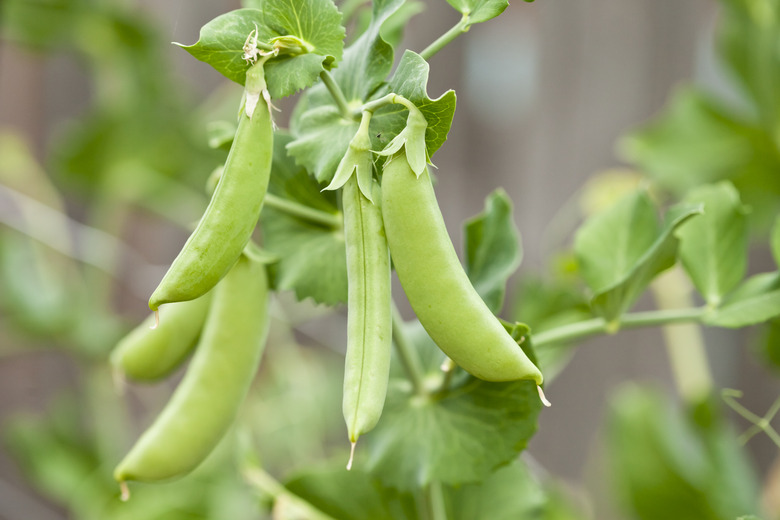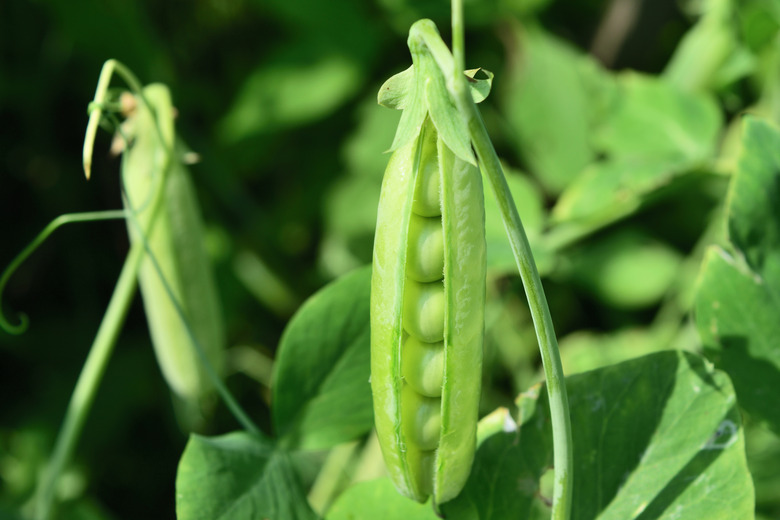How To Grow Peas
We may receive a commission on purchases made from links.
Peas (Pisum sativum) are cool-weather vegetables that are usually one of the first harvests of the spring growing season. A member of the Fabaceae plant family, peas are related to soybeans and peanuts. This plant is an annual, and it comes in both bush and climbing varieties. Peas tend to be an easy vegetable to grow, with very few of the pests or problems that trouble other plants that are grown for food and are also pretty low maintenance for even the novice gardener.
Where Do Peas Grow Best?
Where Do Peas Grow Best?
Peas are one of the oldest crops cultivated by humans, and the wild pea plant can be traced back to the Mediterranean. Today, there are a number of different varieties grown throughout the world. The pea itself is a seed grown in a protective pod that matures on a network of vines. Rich in fiber and low in fat, this vegetable has remained a staple in gardens and on tables for a very long time.
Pea plants grow best as annuals in USDA plant hardiness zones 2 through 11. It can be helpful to place them somewhere in the garden where the trellis will be shielded from strong winds, playing children or other potential disturbances. In areas that experience a lot of heat early in the summer, it may be better to plant this vegetable as a fall crop. For cooler climates, a spring planting will bring about a more bountiful harvest.
When Should You Plant Peas?
When Should You Plant Peas?
Peas need to be planted very early so that they get a good start in the coolest spring weather. One good if general recommendation is to get them in the ground prior to St. Patrick's Day. This vegetable can be planted as early as four to six weeks before the last frost date in the spring, six to eight weeks prior to the first fall frost date or in late fall or early winter for a winter crop in the warmest zones. The average time from planting to picking is around 60 to 70 days, so use that as a guide or check the seed packet for specific details.
Planting strategies will depend on the climate zone, as the soil needs to be at least 45 degrees Fahrenheit in the spring for the pea seeds to germinate. Ground temperatures will also affect the speed of growth. Young plants can take some minor snow without issue, but a severe frost may kill the peas. If this happens, it may be possible to replant if there is enough cool weather left for the peas to mature.
Preparing the Garden Bed
Preparing the Garden Bed
Plant peas in a bright, sunny location in the garden, as this plant thrives in full sun. The trellis can make a nice accent piece in a garden space, so consider that when laying out the garden map and deciding on materials. Be sure to factor in a little room for the foot traffic of harvesting so other plants don't get trampled in the process.
Peas need soil that drains well, so don't plant them in spaces where water pools or puddles on the ground. If the soil tends to be more of a heavy clay, think about going with raised planting beds that are a minimum of 6 to 8 inches deep to help encourage drainage, and you should work in some compost prior to planting. Either way, be sure to till the soil well to loosen it and provide a good growing space for the seeds.
Starting Peas From Seed
Starting Peas From Seed
Planting peas from seed is the preferred method for growing this vegetable. Soak pea seeds in water the night before planting and sow about 2 inches apart. Seeds should be planted about 1 inch deep in moist, well-drained soil. One advantage to growing this vegetable in the garden is that it takes up very little ground space since peas pretty much grow upward and not outward.
Pea plants come in both bush and climbing varieties. Generally speaking, both types need some kind of support for the plants to grow well. Gardeners will need to craft some type of support or trellis for the peas, as the vines need to climb and the little tendrils will be reaching out almost immediately to grab on to something and begin their ascent. Even so, this type of structure may influence where the peas will be located in the yard.
Trellises can be made from bamboo poles or lumber with string, netting, chicken wire or other materials to help support the climbing vines. For those who want to invest in a longer-lasting support grid or those who prefer to purchase netting, there are various types of pea trellis materials sold through home improvement stores or online garden supply shops. Generally, the supports should range from 2 to 8 feet tall. Check the specific pea variety to figure out the best size and consider how easy they will be to harvest as well; higher isn't always better, it's really just a matter of preference.
Caring for Peas
Caring for Peas
Water the seedlings frequently until the plants get established — about an inch a week or whatever is needed to supplement the rain to add up to that amount. Use mulch to help keep soil cool in warmer weather. This will also help cut down on weeds, which can cause problems for the pea plants. When weeding, use care because the root system is close to the surface and can be damaged fairly easily.
Peas are not considered to be very heavy feeders, and they do pretty well in most types of soil. Although compost is a great addition, be sure not to amend it with any nitrogen-rich fertilizer, as peas produce this element themselves as they grow. The vegetable also likes a pH between 6 and 7.5. Rotate crops periodically to help prevent disease and plant vegetables that need nitrogen-rich soil where the peas once grew; the soil will be primed and ready for them.
Harvesting Your Peas
Harvesting Your Peas
Once pea plants begin flowering, be sure to keep a close eye on pod maturity. Quick harvesting of the developed pods will encourage further growth and production. The pods themselves should look healthy, green and supple when ripe.
If you are growing garden peas, wait until the pods look a bit swollen with the peas inside. If you are growing one of the other varieties that has an edible pod, pick them when the peas inside are still on the smaller side so they can be used in their entirety.
Pick pea pods in the morning when they are most crisp. To remove them from the vine, simply hold it firmly and pull off the pod. Once the harvest begins, be sure to remove pea pods from the vines regularly, as they will be coming in quite quickly. When picking, keep in mind that any hard pods are past their prime, especially for the varieties where the entire pod and seeds are edible.
Using Peas in the Kitchen
Using Peas in the Kitchen
Peas are definitely a popular garden vegetable, and they are used in a variety of different recipes and cuisines, from a stand-alone side dish to Asian recipes to soups. English peas feature an inedible pod that contains large peas, and they are also referred to as "garden" peas. Snap peas (Pisum sativum var. macrocarpon) have edible pods and peas while snow peas (Pisum sativum var. saccharatum) also have edible pods, but inside, they feature smaller peas.
These three pea varieties are among those that are grown most frequently in the garden. Although each type of pea is a little different, they all share similar planting and growth patterns in the garden.
Remove the pods of English peas before cooking them. This can take a bit of time, but it isn't difficult, especially if you recruit a friend or family member; it will go a lot faster. Cut or snap off the end of the pea pod where it came off the vine, then either pull the "string" along the side of the pod or run your fingernail down the side to release the peas inside. Although these pea pods are edible, they are not palatable, so toss them into a compost bin.
Monitoring for Pests and Other Problems
Monitoring for Pests and Other Problems
Pea plants tend to be very hardy and are pest-free for the most part. If aphids are spotted on the plants, simply give them a hard rinse with the hose, and that should be sufficient. Keep an eye out for snails and slugs and remove them if you see them.
Nematodes can sometimes be an issue, but there are pea varieties available that are resistant to this roundworm. Also, make sure to rotate the crop to new areas of soil periodically to help prevent this and other problems from developing over time.
Tough pea pods may be a sign that the temperatures are too high for the plant. As a cool-season crop, peas prefer temperatures between 55 and 65 degrees for optimal growth. They usually won't do very well above 70 degrees and will begin to die off at temperatures around 80 degrees and higher. Be sure to take these factors into account to maximize the harvest.
Diagnosing Common Diseases
Diagnosing Common Diseases
Seed rot is one of the biggest potential problems for pea plants, so be sure not to overwater plants, and try not to water too late in the day. Mulch can be used to help preserve moisture without overdoing it.
Powdery mildew is sometimes seen but can usually be kept at bay with a good planting location, proper watering and good air circulation. If conditions are favorable for this disease, the plant can be sprayed with fungicide to help prevent growth. If powdery mildew does take hold, spray the plant with neem oil to get it under control.

